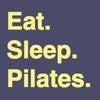Description
About This Video
Transcript
Read Full Transcript
Whether you're brand new to [inaudible] or a these veteran, chances are you've heard the words inhale and exhale in your classes and sessions. There are so many techniques that exist in the plotters world today to help you enhance your breath and to give you cues to think about while you're breathing and doing your exercises. But it's also important for us to take a step back away from the technique and take some inventory of the way that our bodies are managing breath before we start to layer in different exercises and movements. So today we're going to take a few different explorations of the movement of the breathing apparatus to just see where we're at before we start to move on to our bigger exercises. So the first exploration is of the upper and lower portions of the rib cage.
I'm sure you've heard about intercostal breathing at this point of breathing into the sides and the back of the rib cage. And we're just going to check in and see where breath is happening with Amy today. We're going to do that with some feedback. And if you have a yoga strap or any sort of band you can use at home, but with the yoga strap, it gives you a sense of resistance. And also lets you see the three dimensional quality of of word breath is happening all around your ribs. I'm going to bring this up in front there. So the first thing that we're going to do is just feel the strap and notice how it's touching both the front underneath the underarms and on the back of the body.
And it helps to have a little bit of a tension out to the side and maybe even across like, so there we go. So I'm going to ask Amy to just take some normal breaths. And of course with polities experience, chances are you're going to have a little bit of a deeper breath, but anyone at any experience level can use these exercises to help them out. So as she inhales, she's going to just going to feel what it's like for the breath to fill up the space around the band. And as she exhales, she's going to feel our lungs emptying and hopefully feel that the front back and sides of the ribs are coming closer into the center of the body. And now when she does that a few times to get a sense, we'll start to fill up the lungs just a little bit more. And as she inhales, she'll start to stretch the band as much as possible, which won't be is that much. And as she exhales, she's going to empty her lungs and I'm just going to give the band a little bit of a tug so she can feel that she's got a little more to exhale.
So she's going to breathe in through her nose, expanding the strap, and then as she exhales coming all the way back in, and we'll do one more breath here. So she's got breath going into the front of her chest, into the back of her body by her spine and into both sides of the rib cage. Then we're going to take the strap and bring it a little bit lower right around the bottom portion of the ribs. And we're going to do the same exact exercise this time, concentrating on having a little more side to side movement with the breath. So as she inhales, I'm letting a little bit of the resistance go and as she exhales I'm increasing the resistance. I'm not doing this for you for her.
And if she's doing it herself with the strap, certainly she's not pulling tight to kind of create too much of too much pressure on the ribs, but she's letting the breath move the bands. It's a very, very light hold. And the awareness that this is going to help us with is, am I really getting a three dimensional breath or am I breathing more into one portion of my ribcage or another? And this will come in really handy when we go into things that split the body in half, like side bending. So let's drop the strap down. And what we're going to have Amy do is to think about breathing into one side more than the other and then both together. So we'll have you bring your right arm up overhead and your left arm down to a low v. Good. And we'll take a big breath into both sides of the ribs evenly.
And then as you exhale, side bend over to the left side and we'll stay there. So from here, imagining that the strap is around the ribs at the lower portion, we're going to breathe in and expand the ribs on the right side of the body. And as you exhale deep in the side bend and maybe you can go a little bit more good. And then inhale, expanding on the top side and exhale, deepen the side bend. And then one more time, inhale, expanding as if the bandwidth there and exhale, reaching all the way over. And then she'll come up through center and we'll do the same thing on the other side. So we'll lift breathing into both sides of the rib cage and exhaling all the way over to the right and on this side. Same idea, three-dimensional breath, but there's more space on the left side that she can take or take advantage of each time. On the inhale, she's stretching and filling up and then deepening the side bend as she goes over. And you can see how she's able to get a little bit more each time with the breath, but also with the awareness of where the breath is able to go. And then as she takes a deep breath in, coming back into the center and we'll just take the arms up to a high V, breathing into both sides on the inhale and then exhale, lower the arms down and even the movement of the arms can be influenced by the way that she's using the breath. We'll do that two more times.
So thinking about the arms floating onto the back and that sense of filling up the whole upper torso
And the one thing we want to be aware of for any of the props that we're using today is that there simply for feedback, and we're not trying to lift weights with our breath necessarily, but because we put a little extra weight on the sternum, I'm going to ask Amy to take a breath in and instead of pushing the rate up, if you can show what that would look like by arching her back, that's not what we're looking for. We're going to think about allowing the breath itself to move the dumbbell. So she takes her breath in, she can feel the weight lifting and slightly arking up and as she exhales, the feedback of the weight is going to drop down. Allowing her to feel that full range of motion on the exhalation. We'll do that two more times.
Breathing and lifting in and exhale, and she can almost start to feel a slight sliding downward towards her pubic bone. We'll do it one more time and exhaling and letting everything just drop and create a deeper connection through the mat. Now this exploration can lead us to a movement understanding that will help us into our upper contraction or our abdominal curl. So the breath in is going to remain the same. We can take the deep breath in and as she exhales she'll start to feel the weight sinking down, sliding the hands towards the heels, nodding the chin forward, and feeling a slide of that dumbbell downward towards the pubic bone. So rather than pushing herself up, she's really reaching down with the ribs towards the hips and then she'll take an inhale and exhale to lower back down the weight, helping her make a connection back through the back of the body.
Let's do that one more time and exhale. One of the places I find is to be the most useful is for the hundreds who want to stay in this position. Let's pump the arms. Two breaths in, two breaths out. Good. So on the inhale we can go back to that original awareness of the breath through the upper portion of the ribs, starting to fill up the upper body and then reminding us of the ability to release the air as the weight sinks down with h exhalation. And last one. Good. And then let's reach all the way back. Excellent. So we'll take that one the way for a moment.
So the last exploration is for the diaphragm and we're going to allow as PyLadies enthusiasts are bellies to completely release, which might feel awkward based on what your experience has been with glottis. But remember our breath wants to mimic our ability to move through life in a nice, easy fashion. And we want to make sure that we're working a nice stretch and contraction relationship with the breath rather than walking around bound all day long. So I'm going to ask Amy to breathe into her belly and just let the belly release as much as possible, feeling the air reaching down towards her pelvic floor and then as she exhales to let the weight of your internal organs, whatever you ate a little bit ago, all of the insights waiting down to the mat to try to feel a sense that your skeleton is simply housing a nice hammock for the weight of your internal organs to rest into good. So once we find that it's a very simple way, and if you're unsure, you can use something very small weighted, such as a little book placing onto the belly. Now again, we're trying not to pop the book up by really hardening or tensing our abdominal muscles out. This is going to be very easy effort, hardly any work at all of the belly other than the breath just sending down.
So on the inhale, she's breathing in towards the pelvic floor, feeling the book naturally rise as she exhales, she's emptying her lungs and instead of tightening or pulling the belly and she's just allowing that book to sink all the way down. We'll do that two more times. And sometimes taking a moment to just feel what's happening without forcing it to happen can really enhance your understanding of why an exercise is maybe challenging to you in your math classes or in your private sessions. So this is a great way just to center and also become aware of that breath. So the last exploration we're going to do is a piece called integrating the hemispheres.
And we're going to work with the upper and lower hemispheres of the body and with the breath into both. So the first thing that we're going to do is just take a moment to picture the body as an empty shell so that there's lots of space inside because we're going to be sending our breath all the way down to the feet. And what I'll ask Amy to do is to first take the breath all the way down to the belly like we did with the last exercise with the book down to our pelvic floor. And even imagine that it could travel all the way down the legs, all the way down to the soles of the feet. And each time you exhale you're going to try to feel more of a connection to the back of your body simply by releasing as if it was getting heavier to the mat.
So places of interest would be your heels, your cafs, maybe the backs of your hamstrings, the backs of your pelvis, potentially the lower back, but not necessarily depending on the shape of your spine. And right now we're just working from the waist down, so she's taking a deep, deep breath in imagining all of the space in her legs and her pelvis filling up and as she exhales, letting the heels, the calves, the hamstrings of pelvis, everything weight down just like it felt when that book sunk towards the Mat. And we'll do one or two more like that. So breathing in through the legs, through the calves, through the heels, and as she exhales emptying out all of the lower body. And of course we can't really isolate the two from each other, but mentally we're just trying to bring again a sense of awareness of breath and how it's affecting the lower body and potentially helping our bodies release a bit to the mat so that when we go for a plot is exercise. We can use the mat as some resistance, some leverage and some feedback for how our body is moving on it.
So second part is the upper body. So we're going to take the breath into the ribcage just like we did with the strap and the little dumbbell expanding the ribs as much as possible. And then as she exhales, she's going to try to find that sinking sensation of connecting the back of the ribs down. The hardest part about this is that we are so used to using our abdominals that we want to crunch into it and force it down. Think of the term anchor and, and what actually happens when a boat drops the anchor through the waters that there's weight has to move through resistance, but it doesn't pull the whole boat down with it. So as we're exhaling, we're just trying to feel that we have the back of the body reaching down to the mat with resistance but also with some letting go. So again, taking a breath in and then allowing that weighted feeling to come into the body, hopefully connecting more to the back of the rib cage, back of the underarms, allowing the chest to open with some release. Now we're going to start to get a little more active as we integrate the hemispheres towards each other.
And it helps to think of the two half some of the body kind of interconnecting on the exhalation and stretching but not disconnecting on the inhalation. So as we breathe in, she's taking that breath all the way down to the soles of the feet and really feeling the whole body fill up, letting the belly go as much as she can. There we go. And then on the exhale, weighting down through the heels, the calves feeling the belly sink, feeling the ribs connect, feeling the chest open is everything imprints to the mat. And again, breathing in. And this idea of imprinting is if we were to hover her above the mat, we should be able to see a nice impression of the body on the mat.
And the more we can impress onto the mat, the more we can use the map to help us with our roll-ups. I we'll do one more like that and exhaling all the way down. Now if we want to get really coordinated, we can start to breathe into the lower body. Exhale. That's it. I need that connection. Good to the upper body, opening the ribs, breathing into the chest, broadening and then deepening the connection down.
And then with the two halves connected, breathe into the connection to the mat. So feel your body reaching down, expanding heavy and waited and then exhaling, connecting even deeper. So at this point as a teacher, I would say now she's ready to something like the roll up or an abdominal curl because her back now has a relationship with the mat through the breath and the breath will best help her through that movement. So let's try it. So we'll bring the legs together and we'll just keep the arms by the side. You're going to take the same idea breathing all the way down to the soles of the feet on your inhalation, on your exhalation, using the slide of the sternum, the reaching of the ribs, and then continuing to use your breath up and over all the way forward.
Now we're working through the back so we can think that the strap on the back, breathing in and then as she exhales imprinting through the heels, the calves, the hamstrings, the pubic entailed bone all the way down back into the impression that she just left. We'll do that one more time. Breathing in sternum slides, ribs connect in through the center. Pelvis is heavy and she rounds up and over and then she takes a breath into the back of the body. And then exhales all the way back down in printing heels, calves, and again, imprinting, not pushing, just letting the weight of your body help you out. Because the more we move with ease, the more our brain will say, I want to do this again. So that is our breathing tutorial.
Thank you.
Comments
You need to be a subscriber to post a comment.
Please Log In or Create an Account to start your free trial.



















